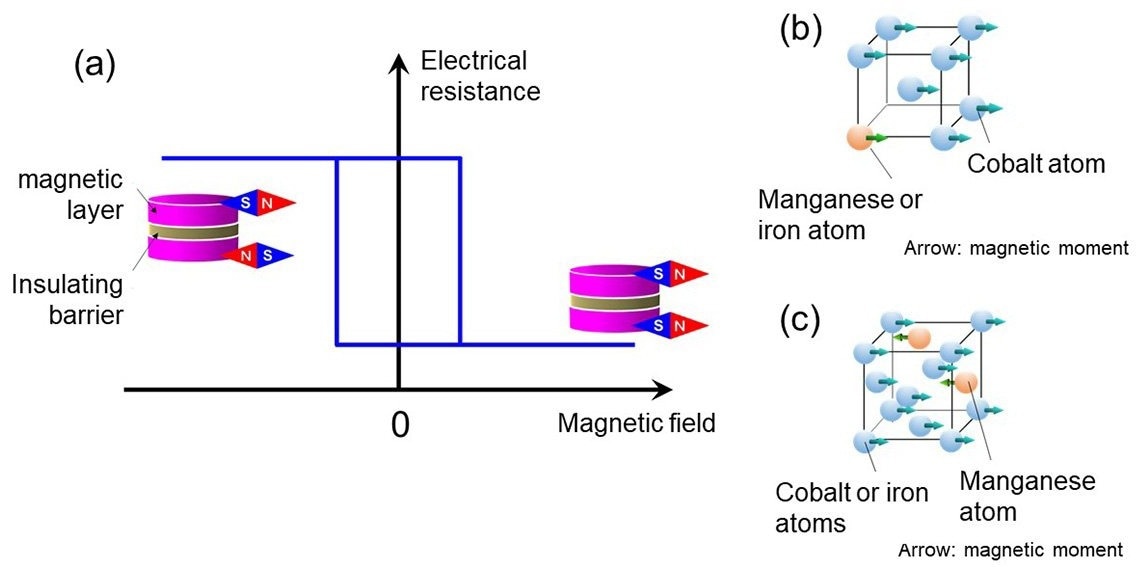A team of scientists from Tohoku University has presented a new material with huge magnetoresistance, opening the path for developments in non-volatile magnetoresistive memory (MRAM).
 (a) A schematic diagram of a tunnel magnetoresistive device and magnetoresistance. (b) A schematic diagram of the crystal of the metastable body-centered cubic cobalt-manganese alloy studied. (c) A schematic diagram of the face-centered cubic structure, which is one of the thermodynamically stable phases of cobalt-manganese alloys. Image Credit: Shigemi Mizukamai and Tomohiro Ichinose
(a) A schematic diagram of a tunnel magnetoresistive device and magnetoresistance. (b) A schematic diagram of the crystal of the metastable body-centered cubic cobalt-manganese alloy studied. (c) A schematic diagram of the face-centered cubic structure, which is one of the thermodynamically stable phases of cobalt-manganese alloys. Image Credit: Shigemi Mizukamai and Tomohiro Ichinose
In the Journal of Alloys and Compounds on May 29, 2023, specifics of their exclusive discovery were published.
At present, the challenge for advancements in hardware, which can successfully process huge quantities of digital data, and sensors, has never been this significant, specifically with governments employing technological innovations to attain intelligent societies.
Most of these sensors and hardware depend on magnetic sensors and MRAM, and tunnel magnetoresistive devices make up most of those devices.
Tunnel magnetoresistive devices use the tunnel magnetoresistance effect to sense and quantify magnetic fields. In magnetic tunnel junctions, this is tied to the ferromagnetic layers’ magnetization. A low resistance state is noticed when the magnets are aligned, and electrons can seamlessly tunnel via the thin insulating barrier between them.
The tunneling of electrons gets less efficient and results in higher resistance when the magnets are not aligned. This resistance change is expressed as the magnetoresistive ratio, a vital figure in finding the efficacy of tunneling magnetoresistive devices. The more the ratio of magnetoresistance, the more improved the device is.
Current tunnel magnetoresistive devices include magnesium oxide and iron-based magnetic alloys, such as iron-cobalt. In ambient conditions, iron-based alloys comprise a body-centered cubic crystal structure and show a huge tunnel magnetoresistance effect in devices with a rock salt-type magnesium oxide.
There have been two remarkable studies using such iron-based alloys that generated magnetoresistive devices exhibiting high magnetoresistance ratios. In 2004, the first was by the National Institute of Advanced Industrial Science and Technology in Japan and IBM. In 2008, the second came when scientists from Tohoku University reported a magnetoresistance ratio that exceeded 600% at room temperature, something that jumped to 1000% with temperatures around zero kelvin.
Since those discoveries, several companies and institutes have invested substantial effort in refining device physics, processes, and materials. However, apart from iron-based alloys, only specific Heusler-type ordered magnetic alloys have shown such huge magnetoresistance.
Recently, Dr. Tomohiro Ichinose and Professor Shigemi Mizukami from Tohoku University started thermodynamically exploring metastable materials to develop a new material capable of demonstrating similar magnetoresistance ratios. To do so, they focused on the strong magnetic properties of cobalt-manganese alloys, which have a body-centered cubic metastable crystal structure.
Cobalt-manganese alloys have face-centered cubic or hexagonal crystal structures as thermodynamically stable phases. Because this stable phase exhibits weak magnetism, it has never been studied as a practical material for tunnel magnetoresistive devices.
Shigemi Mizukami, Professor, Tohoku University
In 2020, the team reported on a device that employed a cobalt-manganese alloy with a metastable body-centered cubic crystal structure.
Employing high-throughput experimental methods and/or data science, they built upon this discovery and were efficient in attaining huge magnetoresistance in devices by adding a small amount of iron to the metastable body-centered cubic cobalt-manganese alloy. At room temperature, the magnetoresistance ratio was 350%, exceeding 1000% at a low temperature. In addition, the device fabrication used the sputtering method and a heating process, which is compatible with current industries.
We have produced the third instance of a new magnetic alloy for tunneling magnetoresistive devices showing huge magnetoresistance, and it sets an alternative direction of travel for future improvements.
Shigemi Mizukami, Professor, Tohoku University
Journal Reference:
Ichinose, T., et al. (2023). Large tunnel magnetoresistance in magnetic tunnel junctions with magnetic electrodes of metastable body-centered cubic CoMnFe alloys. Journal of Alloys and Compounds. https://doi.org/10.1016/j.jallcom.2023.170750